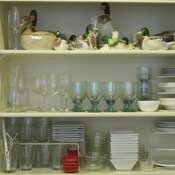If home is where the heart is, some people probably have heart disease. Just like we sometimes show our worst selves to the people we love the most, we often let our homes become reflections of the worst parts of ourselves.
Messy. Disorganized. Even disheartening.
Underlying many design problems is a different problem: chronic disorganization. Spending Saturday reorganizing a house is not nearly as fun as time spent pondering color schemes and redecorating. Everyone loves a fresh new look. Here are some design tips that are really basic organization tips in disguise.
Whenever possible, use color to direct the eye while keeping the "bones" of your home static. You may not want your home to have a basically (boring) neutral color scheme, and you don't have to. Instead, pick your base colors—neutral or not—and then use other colors as accents. These spots of contrast move the eye around the room and add visual order.
Go for simple abundance. This is the contrast of simple with many. Think of an inexpensive glass cylinder filled with a lot of single, simple objects. Blue marbles. Gold Christmas ornaments. This juxtaposition of a simple container and an abundance of contents is usually attractive. Your main living space will look more pleasing with a single color couch covered in many colorful pillows than a space filled with four pieces of upholstered furniture competing for attention.
Use color for organization whenever possible: blue towels for guest bathroom and brown towels for the master bathroom. By designating colors for areas of your home, the spaces look more harmonious and you know where things go.
Create a "stash point" in every room. This is a place where current projects or work can be neatly stowed out of sight but retrieved quickly when work resumes. Neat square baskets work well. Pay your bills on the kitchen table, and then stash the file, checkbook, stamps and statements in the basket at mealtime. This sort of "stash point" is not to be mistaken for permanent storage, however.
Avoid recreational shopping. When you get a case of the living-space blues, don't shop to assuage it. Instead, go through your home and look for things that don't belong there. Return items you have borrowed from friends and family. Gather up unused items for Goodwill donations. This will free up some space. Only then should you begin shopping.
Shop really local. When actually shopping for your home décor, first start in your own home. Things you like but have stashed in closets, in the attic and in the back of the cabinet are the best bargains. Those things made you happy when you acquired them. See if they still do. If not, think of Salvation Army. As for acquiring new items, don't forget to ask around. Your blessing may be someone else's burden.


